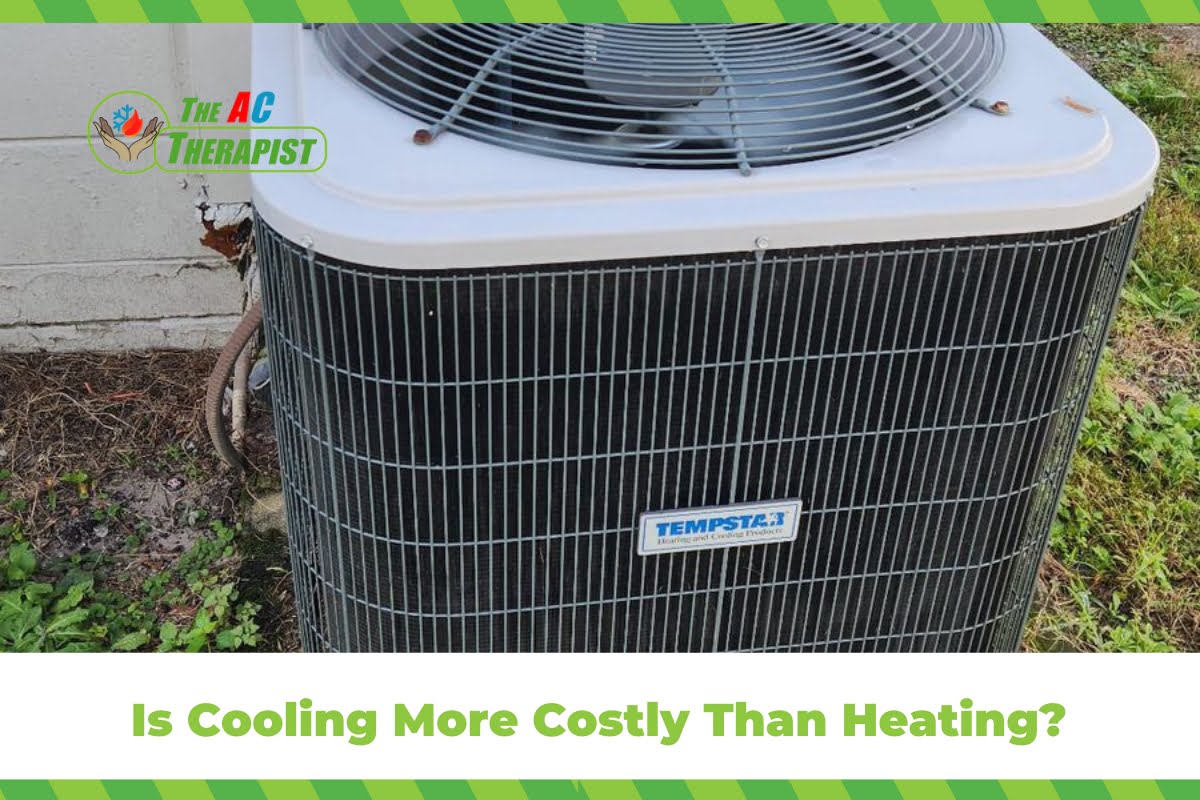Is Cooling More Costly Than Heating?
As homeowners in the vibrant Tampa Bay area, understanding the costs associated with heating and cooling our homes is crucial for both comfort and budgeting. At The AC Therapist, we’ve dedicated ourselves to not only providing top-notch HVAC services but also educating our community about the intricacies of their systems. A common question we encounter is: What costs more, heating or cooling a home? This question is particularly relevant in our region, where the climate plays a significant role in our daily lives.
In this comprehensive guide, we’ll delve into the world of HVAC systems, comparing the costs of heating and cooling in residential and light commercial properties. We aim to provide you with a clear understanding of where your money goes when you adjust that thermostat and how you can optimize your system for both comfort and cost-effectiveness.
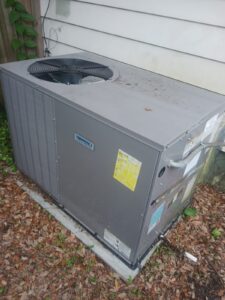
Basic Principles of Heating and Cooling Systems
Understanding the basic principles of heating and cooling systems is essential for homeowners, especially in areas like Tampa Bay where both heating and cooling are integral to maintaining home comfort throughout the year. At The AC Therapist, we believe in empowering our clients with knowledge that helps them make informed decisions about their HVAC systems. Let’s dive into how these systems work and the role of energy efficiency in their operation.
How Heating Systems Work
- Furnaces: Furnaces are one of the most common heating systems in residential and light commercial properties. They blow heated air through ducts that deliver warm air to rooms throughout the home via air registers or grills. Furnaces may be powered by electricity, natural gas, or fuel oil. In a gas furnace, a burner heats the air, which is then circulated by a blower. In electric furnaces, electric heating elements perform this function.
- Heat Pumps: Heat pumps are increasingly popular due to their efficiency. They work by extracting heat from the outside air (even in cold temperatures) and transferring it inside. In warmer months, this process is reversed to cool the home, making heat pumps a versatile option for both heating and cooling. They are particularly energy-efficient because they move heat rather than generate it.
How Cooling Systems Work
- Air Conditioning Units (AC): Traditional AC units cool homes by taking in warm air and passing it over a refrigerant-cooled coil. The refrigerant absorbs the heat, and the now-cooled air is circulated back into the home. These systems often work in tandem with a home’s furnace using the same ductwork to distribute air.
- Mini-Split Systems: Mini-splits, or ductless systems, are an efficient way to cool (and often heat) individual rooms or zones within a home. They consist of an outdoor compressor/condenser and one or more indoor air-handling units. These units are connected by a conduit housing the power cable, refrigerant tubing, and a condensate drain. Mini-splits are ideal for homes without ductwork and for room additions or areas where ductwork extension is impractical.
Energy Efficiency in Heating and Cooling
Energy efficiency is a key factor in both heating and cooling systems. Efficient systems use less energy, reduce utility bills, and have a lower environmental impact. Here are some aspects that affect energy efficiency:
- SEER and AFUE Ratings: For cooling systems, the Seasonal Energy Efficiency Ratio (SEER) rating measures the air conditioner’s efficiency. The higher the SEER rating, the more efficient the unit. For heating systems, the Annual Fuel Utilization Efficiency (AFUE) rating indicates how efficiently the furnace converts fuel into heat. Higher AFUE ratings signify greater efficiency.
- Regular Maintenance: Efficiency is not just about the equipment; it’s also about maintenance. Regular maintenance, such as that offered in our Therapy Maintenance Plans, ensures systems are running at peak efficiency. This includes cleaning air filters, inspecting ductwork, and ensuring all components are in good working order.
- Smart Thermostats and Zoning: Installing smart thermostats and implementing HVAC zoning can significantly improve energy efficiency. Smart thermostats optimize heating and cooling schedules based on your habits, while zoning allows for different areas of a home to be heated or cooled independently, reducing unnecessary energy use.
Factors Influencing Heating and Cooling Costs
For homeowners and businesses in the Tampa Bay area, understanding the factors that influence heating and cooling costs is crucial for managing energy expenses effectively. At The AC Therapist, we recognize that several key factors play a role in these costs. Let’s explore these elements, particularly focusing on the local climate, types of HVAC systems, and the impact of home insulation and energy leakage.
Climate and Weather Patterns in Tampa Bay
- Hot and Humid Summers: Tampa Bay is known for its hot and humid summers. The demand for cooling during these months is significantly higher, leading to increased use of air conditioning systems. This extended usage can result in higher energy bills due to the cooling systems working overtime to maintain comfortable indoor temperatures.
- Mild Winters: Winters in Tampa Bay are relatively mild compared to northern regions. However, there are still periods when heating is necessary. The type of heating system used can affect overall costs, especially if the system is not well-suited to the mild winter climate of the area.
- Year-Round Humidity: The high humidity levels in Tampa Bay can also impact both heating and cooling systems. Air conditioners and heat pumps often have to work harder to remove excess moisture from the air, which can lead to increased energy consumption.
Types of Systems: Age, Model, Efficiency
- Age of the System: Older HVAC systems are generally less efficient than newer models. As systems age, they can lose efficiency, requiring more energy to heat or cool the same space. This inefficiency directly translates to higher energy costs.
- Model and Technology: The specific model and technology of an HVAC system greatly influence energy consumption. Systems with higher SEER (for cooling) and AFUE (for heating) ratings are more efficient. Newer models often come with energy-saving features that older systems lack.
- System Maintenance: Regular maintenance can significantly impact the efficiency of heating and cooling systems. Well-maintained systems operate more efficiently and have a longer lifespan, which can help in controlling costs. This is where maintenance plans, like those offered by The AC Therapist, become valuable.
Home Insulation and Energy Leakage
- Quality of Insulation: Proper insulation is key to maintaining a comfortable indoor environment. Good insulation helps keep cool air in during the summer and warm air in during the winter, reducing the workload on HVAC systems. Inadequately insulated homes can lead to higher energy usage and costs.
- Windows and Doors: Drafty windows and doors can lead to significant energy loss. Ensuring these are well-sealed and insulated can help maintain indoor temperatures more efficiently.
- Ductwork Condition: The condition of ductwork is also crucial. Leaky or poorly insulated ducts can result in significant energy loss, as heated or cooled air escapes before reaching its intended destination within the home.
- Energy Leakage: Other forms of energy leakage, such as gaps in building materials or uninsulated attics, can also affect heating and cooling costs. Identifying and addressing these leaks can lead to more efficient system operation and lower energy bills.
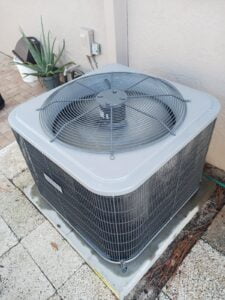
Cost Analysis of Heating
In the Tampa Bay area, while heating may not be as prominent a concern as cooling, it still plays a vital role during cooler months. Understanding the costs associated with heating can help homeowners and businesses in the region make informed decisions. Here’s a breakdown of the average costs, types of heating systems, and their associated maintenance and repair costs, including options like our Therapy Maintenance Plans.
Average Costs of Heating in Residential and Light Commercial Properties
- Utility Expenses: The cost of heating can vary significantly based on the type of fuel used (electricity, gas, etc.), the size of the property, and the efficiency of the heating system. In Tampa Bay, where heating needs are less intense, the costs are generally lower compared to colder regions. However, spikes in energy prices can still impact monthly bills.
- Seasonal Variations: During mild winters, heating costs are relatively low, but during unusually cold spells, these costs can increase due to higher usage.
Types of Heating Systems and Their Costs
- Furnaces: Gas furnaces are common and their initial installation cost can range widely depending on the size and model. Electric furnaces, while cheaper to install, often lead to higher utility bills due to the cost of electricity compared to gas.
- Heat Pumps: Heat pumps are increasingly popular in regions like Tampa Bay due to their efficiency and dual functionality (heating and cooling). The installation cost for a heat pump system can be higher than traditional furnaces, but they typically result in lower monthly energy bills.
- Efficiency Factors: High-efficiency models, while more expensive upfront, can offer significant savings in the long run through reduced energy bills.
Maintenance and Repair Costs
- Regular Maintenance: Regular maintenance is crucial for keeping heating systems running efficiently and preventing costly repairs. Neglecting maintenance can lead to decreased efficiency and higher operating costs.
- Therapy Maintenance Plans: At The AC Therapist, we offer various maintenance plans that cater to different needs and budgets. Our plans start at Value $14.99 for one maintenance visit a year and 5% off on services, Premium for $19.99 with two visits plus duct sanitation and 10% off, and Elite for $39.99 with two visits, UV light installation, filters for the year, and 15% off. These plans not only help in maintaining the efficiency of the heating systems but also in reducing the overall repair costs by catching issues early.
- Repair Costs: The cost of repairs can vary depending on the nature of the problem. Regular maintenance can help identify potential issues before they become major, thereby saving on expensive repairs.
- Replacement and Upgrade Costs: Eventually, heating systems may need to be replaced. Investing in a more energy-efficient system can lead to long-term savings, despite the higher initial cost.
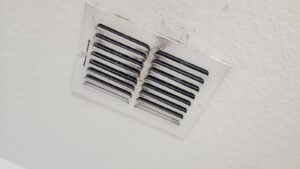
Cost Analysis of Cooling
In the Tampa Bay area, cooling is a significant aspect of residential and light commercial property maintenance due to the hot and humid climate. Understanding the costs associated with cooling is essential for budgeting and making informed decisions about HVAC systems. Let’s explore the average cooling costs, the costs associated with different cooling systems, and the importance of maintenance, including options like our Therapy Maintenance Plans.
Average Costs of Cooling in the Tampa Bay Area
- Utility Expenses: The cost of cooling can vary based on several factors, including the size of the property, the efficiency of the air conditioning system, and the local electricity rates. In Tampa Bay, where air conditioning is used extensively, especially during the long, hot summer months, these costs can constitute a significant portion of a household’s or business’s utility expenses.
- Seasonal Usage: The extensive use of air conditioning during the summer months typically results in higher energy bills during this period. The exact cost can fluctuate year by year, depending on the intensity of the summer season.
Different Cooling Systems and Their Costs
- Traditional AC Units: The cost of installing a traditional central air conditioning system can vary widely. Factors influencing cost include the unit’s capacity (measured in tons), SEER rating (efficiency), and any necessary ductwork modifications. While the initial investment can be substantial, central AC systems are effective for cooling entire homes or large spaces.
- Mini-Split Systems: Ductless mini-split systems are an increasingly popular option for targeted cooling or homes without existing ductwork. They are generally more energy-efficient and can be more cost-effective to install compared to central air systems, especially in smaller spaces or when adding cooling to specific areas. The installation cost depends on the number of indoor units required and the overall capacity of the system.
- Efficiency and Long-Term Savings: Higher-efficiency models, whether central AC units or mini-splits, typically come with a higher initial cost but can offer significant savings in the long run through reduced energy bills.
Maintenance, Including Therapy Maintenance Plans
- Importance of Regular Maintenance: Regular maintenance is crucial for keeping cooling systems running efficiently, extending their lifespan, and preventing costly breakdowns. Maintenance tasks include cleaning or replacing air filters, checking refrigerant levels, and inspecting electrical components and controls.
- Therapy Maintenance Plans: At The AC Therapist, we offer various maintenance plans tailored to different needs. Our plans include the Value plan at $14.99 for one maintenance visit a year and 5% off on services, the Premium plan at $19.99 with two visits plus duct sanitation and 10% off, and the Elite plan at $39.99 with two visits, UV light installation, filters for the year, and 15% off. These plans help ensure that cooling systems are maintained regularly, which is key to efficient operation and cost savings.
- Cost of Neglecting Maintenance: Failing to maintain a cooling system can lead to decreased efficiency, higher utility bills, and more frequent and costly repairs. Regular maintenance can identify and address issues before they escalate, saving money in the long run.
Why Heating Takes More Energy?
Heating often requires more energy than cooling for several reasons, particularly in regions with colder climates. Here are some key factors that contribute to this:
- Temperature Differential: The basic principle of thermodynamics states that energy moves from a warmer area to a cooler one. In cold climates, the difference between the outside temperature and a comfortable indoor temperature is usually much greater than the difference in warmer climates for cooling. For instance, if it’s 0°F (-18°C) outside and you want to maintain a comfortable 70°F (21°C) indoors, that’s a 70-degree difference. In contrast, cooling a room from 90°F (32°C) to 75°F (24°C) involves only a 15-degree difference. The greater the temperature differential, the more energy is required to maintain the desired indoor temperature.
- Heat Energy Characteristics: Heating typically involves increasing the energy state of the air inside a home, which can require more energy input. Cooling, on the other hand, often involves removing heat from the indoor air, which can be more energy-efficient than generating heat.
- Efficiency of Heating Systems: The efficiency of heating systems can vary. For instance, electric resistance heaters are less efficient compared to heat pumps. In regions where electricity is used for heating, this can lead to higher energy consumption compared to areas where more efficient heating systems or fuels are used.
- Insulation and Building Envelope: The efficiency of a building’s insulation and its overall ability to retain heat significantly affect heating energy use. Poor insulation and air leaks mean that heat escapes more easily, requiring the heating system to work harder and consume more energy to maintain a comfortable indoor temperature.
- System Design and Maintenance: The design and maintenance of a heating system also play a crucial role in its energy consumption. An older, poorly maintained heating system will generally be less efficient than a newer, well-maintained system. Regular maintenance, like that provided by HVAC specialists such as The AC Therapist, can help ensure that heating systems operate as efficiently as possible.
- Type of Fuel Used: The type of fuel used for heating also impacts energy consumption. Electric heaters, while convenient, often have higher operational costs compared to natural gas or oil heating systems in areas where electricity rates are high.
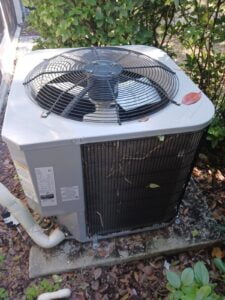
Heating vs. Cooling in Tampa Bay: Navigating the Costs with The AC Therapist
In conclusion, the debate about the costs of heating and cooling in the Tampa Bay area is nuanced and depends on various factors, including the type of system, usage patterns, and maintenance practices. While cooling generally incurs higher expenses due to the region’s hot and humid climate, efficient systems and regular maintenance can significantly mitigate these costs.
At The AC Therapist, we understand that every home and business has unique needs. Whether it’s installing an energy-efficient mini-split system, maintaining a robust central air conditioning unit, or ensuring your heating system is ready for the cooler months, our goal is to provide tailored solutions that balance comfort with cost-efficiency.
Remember, investing in the right system and keeping up with regular maintenance, such as our Therapy Maintenance Plans, can lead to substantial savings in the long run. We are here to help you navigate these choices, ensuring that your living or working environment remains comfortable year-round without breaking the bank.
For those in the Tampa Bay area, whether you’re weighing the costs of heating versus cooling or seeking the best HVAC services, The AC Therapist is your go-to expert. Let us help you make informed decisions that optimize comfort and efficiency in your space.

